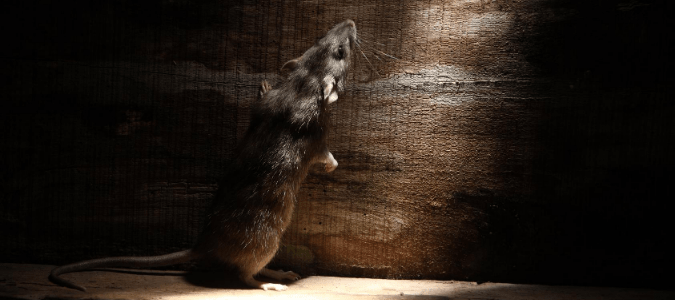
Unfortunately, there are a number of animals that can invade your home in search of shelter, water and food. And, many times, you’ll start noticing the signs of these visitors before actually spotting them. So, how can you determine if you have rats in your home, or something else? One way to differentiate between rats and other creatures is by listening to the sounds they make.
If you have rats in your home, you’ll likely hear several specific noises:
- Scurrying sounds as rats travel from place to place
- Thumps as they play or fight
- Scratching and chewing as they eat and gather supplies for nests
- Squeaks from immature rats coming from a nest
Most vocalizations occur outside of the realm of what a human is capable of hearing. Most audible sounds come from rats that are in a state of distress.
Where will these sounds originate? For most people, your attic. This can be disturbing, because we usually don’t think much about our attics unless we need to get something out of storage.
Since attics are quiet, dark and warm, they’re the perfect home for many types of animals. If you’re hearing noises coming from your attic, it could be any one of a number of different animal pests. Rats are one of the most common attic invaders, but they’re not the only one. Because there are several types of animals that like to live in attics, just hearing a noise isn’t enough to identify the culprit. Instead, you need to pay attention to what you hear and when. Rats are nocturnal, which means that they are most active at night. If rats are the cause of your problem, you’ll hear noises coming from your attic at night when they’re awake and moving.
You already know what sounds to listen for if you suspect you have rats, but what other signs can you look for? The biggest giveaway is droppings. Rat excrement is small and oval-shaped, and you’ll most often find these waste materials near food sources. You may also see chew marks on food packaging.
Additionally, you may notice small holes in the wood in your attic. Rats have incredibly strong teeth, and can easily move through tight spaces. Once they live in your attic, rats will start to chew holes for easier access to the outside world, or just to move from room to room. In addition, gnawing is the only way rodents keep their teeth sharp and short, since they grow continuously. In addition to damage from chewing, you may also notice grease marks and trails around the holes rats use frequently.
Finally, you may spot nests or even a rat itself. Nests are small piles of soft material in dark corners. They often include fur, insulation, old newspaper and anything else that might be soft or warm. If you spot a nest, you’ve probably got a rodent infestation of some kind.
Of course, your attic visitors may not be rats but another type of animal entirely. Other attic invaders can be just as damaging as rats in their own way, so it’s important to identify them, too.
Mice have many of the same behaviors as rats, so a rodent problem will usually have many of the same characteristics. If you have ruled out rodents as the source of your issue, you should know that squirrels, birds, bats and raccoons make some noises you might detect. Fluttering sounds often point to a bird problem. Instead of skittering sounds, you’ll hear faint tapping and then a couple of thumps as the bird takes off. Birds also leave distinct droppings that you are probably more familiar with, typically underneath beams or other elevated positions.
Bats can make squeaking and scratching noises, which you will typically hear at night when these winged mammals are the most active. Raccoons will typically make the loudest sounds if they become trapped in your attic, and you will most likely also notice these at night. Scratching and running noises are the two most common behaviors that can indicate you have a raccoon that has nested in your insulation.
Last but not least, if you hear noises mostly during the day, then you probably have squirrels or a bird problem. These animals are diurnal, so they’re awake during the day and asleep at night. You’ll hear rustling and thumping during the day, but it won’t keep you up at night.
If all signs point to rats, your next question is likely about how to get rid of these creatures. Keep reading to learn how to get rid of rats and how to prevent these unwelcome guests from coming back.

How to Get Rid of Rats in Attics and Other Common Spaces
Once you know you have rats, you’re probably trying to learn how to get rid of these rodents. Rats are bad for your health and bad for your home, so it’s important to take care of these problems as quickly and efficiently as possible.
Traps are typically among the best ways to get rid of rats. However, rats are intelligent, and they are wary of new items in their environment for several days, especially if they smell your scent on an item. As a result, it’s best to leave a trap in place for a few days before you bait it with anything, so the rats have time to acclimate to it. Additionally, you should wear gloves when setting the traps to avoid leaving your scent behind.
There are several ways to bait rat traps. Food is the most common bait, but not all food will attract rats. If you’ve noticed rats consuming food in your home, pay attention to what they’ve been eating. Use that to bait the traps. If you see bite marks on bread, use that to bait traps. If your resident rodents are eating candy, bait traps with sugary sweets. This will prevent the rats from ignoring the food because it’s unfamiliar.
Rat traps should be put near places where rats spend a lot of time or they won’t be effective. If you have found nests, entrance holes or trails through your attic, those are good places to leave rat traps. Once you’ve determined what to put in the trap, you may need to leave it for another few days before it catches anything, so be patient. Moving a trap too often will keep rats suspicious and prevent you from actually catching anything.
Any rats that are in your attic may leave your home regularly as well. That means that you should be placing rat traps both indoors and outside. Usually, rats live in and around the following places:
- Piles of insulation
- Spaces underneath floorboards
- Boxes full of newspaper and objects
- Dense piles of clutter
- Woodpiles outside
- Compost piles
- Dense shrubbery
- Long grass
- Garbage bins
After you have set your traps, look for common rat entry points. Despite their large size, rats can fit through spaces as small as a quarter. Putting traps near rat entryways is a good way to keep these creatures from entering your home and may potentially scare off additional rats. Rats can enter homes through:
- Vents
- Chimneys
- Cracks in walls or the foundation
- Gaps around window frames
- Broken shingles
- Cable entry points
- Open doors
If you have any of the above, you should put traps nearby to keep rats from coming and going as they please.
In order to effectively trap the rats, you’ll need to leave a large number of traps both in your attic and around outside. It will take several weeks to ensure that you’ve completely controlled your rat population, and you’ll need to check traps regularly to avoid problems with odors. If this sounds like a lot of work to you, professional pest control services will be able to help you place these traps appropriately and can use their extensive experience to control your rodent problem more efficiently and effectively.
Once you’ve finally gotten rid of your rat problem, you can focus on keeping these rodents out in the future.

How to Prevent Rats from Getting Back In
Rats, like a variety of other pests, are attracted to warm conditions, water and food. In order to prevent another infestation, you’ll need to follow the same steps a professional would take for effective pest management.
The first step in your rodent prevention plan is to seal all cracks and crevices that could allow unwanted animals to gain entry to your home. You or your pest control specialist can use caulk to fill in small cracks in the walls or foundation. You may also need to patch holes near window frames and improve weatherstripping around doors to make your exterior less vulnerable to pests making their way inside.
To make your property less attractive to rats, seal off vents. Covering dryer and heating vents with mesh lids helps keep rats and other pests from using these devices to move inside. The same goes for your chimney. Rats can climb rough surfaces like unfinished stone and brick, so chimneys are a common way for a rodent problem to get started.
Another important preventative step you can take is to eliminate food sources. Use thick plastic, glass or ceramic containers to hold food instead of the original packaging. Cardboard and thin plastic bags are easy for rats to chew through, but glass isn’t.
Once you’ve sealed off your home, you’ll need to take steps to make your yard less appealing to rats. That way, they won’t return and you won’t have to worry about them entering your house. Keep your grass short and leave ample room between your landscaping and your home. Rats prefer covered, dense areas and tend to avoid open spaces. The more open space your yard has, the less likely rats are to stick around.
You can also trim the trees around your home to reduce hiding spots for rats and other unwanted wildlife. Branches that come near or touch your house are the perfect way for rats to get to your roof. Trimming back these limbs will make it much harder for rats and other animal pests to ever get back into your attic.
Walk through your yard and get rid of any standing water, as this moisture attracts all sorts of pests. Pet water dishes, bird baths and even large puddles can attract pests over time. Keeping your property free of these water sources will encourage animals to move on.
Keeping your property rat-free can be daunting if you discover you have had a problem. While you can do some rodent proofing on your own, it’s quite time-consuming, and may not be effective if you haven’t been faced with a pest problem before. Working with a professional pest control company is a simple, easy and efficient way to get rid of rats and other pests without wasting precious free time. Licensed technicians have the experience to identify and control pests efficiently, saving you the hassle.
ABC Can Remove Unwanted Wildlife From Your Property
Dealing with a rodent infestation can be extremely overwhelming. These larger pests can be intimidating and can even bring smaller pests with them into your home. If you’re ready to evict rats from your property, contact ABC Home & Commercial Services. We create customized solutions to remove all unwanted wildlife from your property and can provide you with ongoing pest control services to handle any size problem and prevent future issues.
